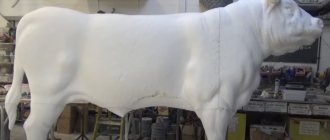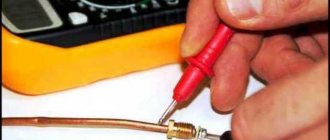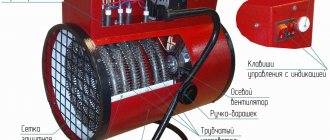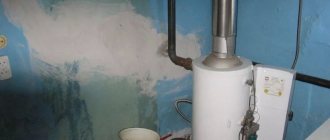Heating systems and water heating devices experience constant changes in pressure and temperature during operation. Overheating or a sharp increase or decrease in the pressure of the working medium can cause breakdown of equipment or a pipeline unit and even a utility accident. To make the operating conditions of heating devices optimal and protect the heating network, devices are used that allow you to regulate the pressure of the coolant and maintain it at the required level - bypass valves.
Purpose and areas of application
Bypass valves are installed in liquid and gas pipelines in which pressure may regularly increase for various reasons. The task of this device is to maintain operating pressure in the system. When the pressure increases in the section of the line in front of the installed valve, it releases part of the working medium into the bypass circuit, thereby reducing the pressure in the main system.
These devices are used in systems:
- cold and hot water supply,
- heat supply from any sources,
- cooling,
- conditioning.
A separate area is the automotive industry. They are installed in cooling and fuel supply systems. Bypass valves in turbocharged automobile engines regulate the air supply to the turbocharger.
Automotive engine turbine bypass valve
What is a bypass in a heating system?
A bypass is a section of pipe installed so that a path is opened for the coolant not only through one device, but also bypassing a certain section of the heating main, as well as parallel to the main pipeline. Often, equipment is installed in the bypass section, one end of which is connected to the inlet pipe, and the other is fed to the outlet pipe.
The section is also equipped with shut-off valves to shut off the flow of coolant through the bypass section and regulate the flow of liquid to the device. In order to be able to disconnect the equipment from the coolant supply, it is recommended to install a valve on the outlet pipe - the installation area of the valve is located between the bypass valve and the outlet of the boiler, radiator, central riser or other device.
A bypass is used in the heating system in the following cases:
- when piping radiators, most often in single-pipe circuits;
- for autonomous heat supply systems when piping pumping equipment;
- for circuits in heated floors in the area of the mixing unit;
- when creating a small circulation circuit for piping solid fuel boilers.
Design and principle of operation of any bypass valve
Its body is made of steel or brass. The main element of the internal mechanism is a shutter (flap) that closes the passage opening. The bolt is held closed by a spring. In some models, its role is played by a membrane or diaphragm. The spring force is regulated by an adjustment lever located on the outer surface of the housing.
Valve design diagram
*
The hydraulics of operation are based on the pressure of the working fluid flow in the pipeline on the valve located inside the housing. As long as the force is less than the lever set by adjustments, the drain hole remains closed. As soon as the pressure becomes greater than the setting pressure, the pressure on the spring leads to its compression. As a result, the drain hole becomes slightly open, and part of the flow is bypassed into the bypass circuit, reducing the pressure in the main hydraulic system.
Then the reverse process occurs - a decrease in pressure leads to the spring expanding and the valve closing, and the valve is again ready for the next reset. Pressure equalization occurs constantly, automatically. When the system operates in the “closed water valve” mode, the bypass channel remains constantly open, ensuring constant recirculation of the media flow through the bypass circuit.
Cross-section of the bypass device
How to install a valve on a water heater
Select the desired model
As a rule, good boilers are delivered to the consumer equipped with a safety valve of the required parameter.
If not, or if replacement is necessary, you will have to buy it yourself. They are inexpensive, 250-400 rubles depending on the model.
If there are no special problems with the threaded part (almost all valves have a ½-inch thread), then the operating pressure of the valve is the value to which special attention is paid. The required pressure value must be clarified in the operating manual of your heater.
The required pressure value must be clarified in the operating manual for your heater.
If you purchase a valve with a lower pressure rating, it will constantly leak. If you select a value greater than the permissible value, the valve may not save you from big troubles when the boiler overheats.
How to install correctly
- Before installing a safety valve for a boiler, the device itself must be turned off and the water drained from it.
- The valve is installed at the cold water inlet to the heater.
The process is simple - the usual “packing” with a key for 3-4 turns using sealants (fum tape or tow, as you like). The second threaded end of the valve connects to the cold water supply system. Be sure to check the direction of the incoming water - it is marked with an arrow on the valve body. - If the pressure in the water supply is not stable, or is excessively increased, it would be better to install a water reducer upstream of the valve.
- Not everyone likes the fact that water starts leaking from the valve from time to time. This is a completely normal phenomenon, indicating that the device copes with its intended task. It would be reasonable to connect the drainage pipe with a flexible hose to the sewer system. The hose must be transparent so that the performance of the valve can be visually assessed.
Sometimes attempts are made to hide the valve out of sight by placing it away from the heater. This approach is also possible, but subject to two conditions:
- It is strictly forbidden to install shut-off devices between the valve and the boiler inlet.
- A long vertical section of water supply will itself increase the pressure on the valve, and completely unnecessary “idle” leakage may begin. In any case, there should be no more than 2 meters between the valve and the boiler.
What should you do if too much water flows through the drainage pipe, even without heating up much?
It is possible that the pressure in the water supply is too high (although this is extremely rare) - in this case, installing a reducer will help.
You should also check to see if you purchased a valve with a pressure reading that is too low and does not match the heater model. If everything is normal here, it means the valve spring is “hooked” and it should be changed.
What should be of greater concern is that the valve is always dry under all circumstances.
If, even at maximum heating, not even a drop of water has ever appeared from it, with a high degree of probability we can talk about its malfunction, clogging or jamming. It's better not to risk it and buy a new one.
The simple installation of this absolutely inexpensive device will protect the life and health of the home owners, preserve their property, and extend the trouble-free operation of the water heater.
Differences from other types of safety valves
Other valves installed for the safe operation of pipelines have a similar device and principle of operation. But they differ in purpose and requirements.
| Valve type | Mechanism of action | Principle of operation |
| Bypass | Installed in a bypass circuit and redirects part of the flow into it | Constantly working as needed |
| Safety | Reduces pressure in the system, throwing part of the media out | In case of emergency pressure increase |
| Reducing | By changing its throughput, it regulates the pressure in the part of the main circuit located after its installation site | Full time job |
The bypass valve reduces the load on the system pumps without changing the amount of media in it.
Specifications
*
The main quantities that determine the operation capabilities of bypass devices in the system:
- Passage diameter. Internal cross-section of the carrier passage through the valve. May differ from the diameter of the main circuit of the system.
- Bandwidth. Characterizes the volume of the working medium capable of passing through the valve per unit time at a nominal pressure of 1 atm. Measured in cubic meters/hour.
- Ultimate pressure. The maximum value of excess pressure for which the device is designed to operate. Exceeding this parameter in the system leads to displacement of the valve rod and the beginning of media bypass. Determined at a carrier temperature of 20 °C.
- Setting range. The limits of the possibility of adjusting the excess pressure at which the valve begins to open. The unit of measurement is bar.
Adjustment scale with tuning slider
Rules for installation and operation of the device
To maximize system protection from overpressure, you must follow the rules for installing and operating the relief valve:
- the connection is made at the outlet pipe of the heating equipment;
- for installation, select the highest possible point of the pipeline;
- the discharge pipe must be connected to a discharge channel connected to the sewerage system;
- the diameter of the valve opening must correspond in area to the internal diameter of the pipe;
- the location of the control device is located in a place accessible for maintenance;
- It is recommended to use quick-release connections;
- if you need to connect pipes after installed valves, then the diameter of the outlet part must be equal to or exceed their cross-sectional area;
- when installing two pressure relief devices, the cross-section of the pipe must exceed the area of the passage openings by a total of 25%;
- It is prohibited to install tie-ins and branches of communications between the boiler and the valve;
- after installation work, you need to make sure that the valve opens at the specified parameters;
- Maintenance should be carried out strictly in accordance with the manufacturer's requirements.
During prolonged use, blockages form on the internal surfaces, which can negatively affect the valve response time.
It is important to use special solutions to clean them. Alcohol or vinegar solutions are suitable for these purposes.
If leaks are noticed on the body, then installing plugs is strictly prohibited, as this can lead to emergency consequences. It is necessary to quickly replace the device by selecting the correct parameters.
To monitor the condition, configure and check the functionality of the valve, you need to use the readings of pressure gauges, temperature sensors and other instruments. This will allow you not to involve specialists, but to solve all the necessary problems yourself.
Types of bypass valves
Although the operating principle and performance characteristics are similar, the devices have additional differences.
Connection method
On small diameter pipelines (up to 150 mm), the inlet and outlet pipes are usually made with a threaded connection. Options - external or internal thread of the pipe. For large cross-section pipelines, connections are made by welding or using flange connections.
Large Diameter Flanged Valves
Flow direction
*
The valve installed in the main flow usually has an angular shape for connecting the outlet circuit. Valves included in the bypass line can also be direct-flow.
Direct Flow Bypass Valve
Active element
Typically, the outlet is blocked by a shutter or damper. But in some designs, the locking element is a diaphragm connected to a rod. The use of diaphragm options is recommended in pipelines with a working medium containing solid particles in addition to liquid or gas.
Mechanism of action
The difference in the method of influencing the shut-off element led to the emergence of two types of valves.
- Direct action. A simple mechanical device in which the coolant directly acts on the active element of the valve. Inexpensive and relatively easy to maintain.
- With elements of indirect influence. It actually consists of two valves. The small diameter valve works as a pressure sensor and, when activated, controls the main valve rod, which opens the drain into the bypass channel. Characterized by more precise adjustment of the response threshold.
Mechanism
The design includes a metal body (cast iron, bronze, brass), inside of which there is a damper and a spring that activates it. The valve can be a spool valve, a plate, etc. Another option is a shut-off membrane with a rod. A handle is built into the body, which is used to adjust the device.
Devices used in large networks and large-diameter pipelines may contain a lever-load mechanism in their housing.
Bypass valve design:
Device selection criteria
Bypass valves are required in the following types of pipelines:
- Boiler storage systems. The water in them is under pressure, and periodic switching on/off leads to sudden changes in the volume and pressure of the flowing liquid.
- Continuous hot water supply systems equipped with temperature control devices. When the temperature changes, the volume of the medium in the line also changes. Constant adjustment and smoothing of pressure differences is required.
- Multi-circuit heating systems. When any of the circuits is turned off, the pressure in the remaining parts increases. Bypass devices minimize load changes on the system pumps.
- Solid fuel heating devices are not capable of sharply reducing the temperature of the medium after shutdown. Bypassing the flow line, the cooling time can be reduced.
When selecting a suitable bypass type safety device, the following parameters must be taken into account:
- Diameter and connection method allowing it to be included in a regulated line.
- The throughput must correspond to the calculated media outlet in case of maximum load.
- Operating temperature of the device and material of its manufacture.
- The need to adjust the valve actuation point. Its range should be within the planned pressure changes.
Focusing on products from a well-known manufacturer is also important.
Air and its release from the heating system
Air congestion is a fairly common occurrence, but an unpleasant one. Characteristics that indicate that there is air in the radiator and bleeding is required:
- presence of noise during operation;
- corrosion.
Pressure plays an important role in any system. There are a number of reasons that can affect pressure changes. One of the most common reasons for an increase in pressure is the formation of an air lock.
Air may appear in the system and require bleeding due to several factors:
- the presence of dissolved air in the water, which, when heated, accumulates in the upper part of the pipe;
- accidental air release during installation;
- when filling the system with water, they did not adhere to certain rules: slowly filling the pipes with coolant;
- air could be sucked in through poor sealing at the joints of the structure.
The heating system air bleed valve is an important and mandatory element in every design. The best way to eliminate air is a multi-stage deaeration system. Air drain elements are installed not in one place, but in several. If started correctly, the air bleeding stage will not be difficult.
The air bleed element is:
- manual;
- auto.
The presence of several drain valves does not imply their simultaneous opening. If this is a multi-story building, then all the air will accumulate in one place and, due to pressure, go to the neighbor. When the bleeder valve opens, a hissing sound is heard, which means that air is escaping from the radiator.
The drain valve must not be opened completely and one at a time
It is important to carry out the air descent slowly, gradually. After a hissing sound, water will begin to drip from the drain valve.
It is important to continue and open the drain element until the water does not drip, but flows in a trickle. This means that the air has escaped.
Installation features
*
The specific installation location of the bypass device depends on the layout and type of pipeline. The valve can be integrated into an additional diverter circuit. For closed-cycle heating systems, excess pressure is released into the return pipeline. It can also be used as a safety valve, adjusted to emergency pressure and with liquid discharge into the sewer system.
In a single-circuit heating main circuit, the bypass valve is installed in the bypass outlet after the injection pump.
Bypass valve for local heating system. Installation diagram.
For greater safety and security of the entire heating circuit, it is advisable to install additional ones in addition to the bypass device:
- check valve to prevent reverse flow direction,
- air vent valve for bleeding air pockets,
- drain valve to completely drain the media from the system,
- for small-diameter cottage-type systems - mesh filters.
In multi-circuit systems, bypass valves are installed in each circuit.
Tips for setup and maintenance
Installing a valve with adjustment of the excess pressure range is worth it to those who already have experience in calculating the required value. The opening of the drain hole begins at the pressure selected by the setting. But it usually opens completely at a pressure exceeding the initial value by 20%. But the calculation cannot be based only on this indicator, because such a decrease in the operating pressure in the system is nonlinear. Relieving part of the carrier already leads to a reduction in the load on the valve shutter. Therefore, to accurately calculate the throughput of devices, they are guided by the diagrams given in the data sheet.
It should be taken into account that the setting error of most regulators is 10%. For initial adjustment and subsequent monitoring, it is recommended to install pressure gauges before and after the bypass point.
The adjustment itself is carried out either by moving the slider along the scale or by rotating the adjusting screw. After setting and checking the required value, the screw is secured with a clamping nut.
Routine maintenance of the bypass valve consists of monthly monitoring of the initial response pressure and its opening speed. You also need to monitor the condition of the filters.
If the valve does not operate correctly, it should be dismantled, disassembled and all parts washed. Perhaps the malfunction is caused by a simple clogging of the mechanism.
Product functions
The functions of such a device are to promptly discharge excess coolant volumes and thus reduce its pressure level. The general requirements for such nodes are that they must :
- help reduce pressure by promptly discharging excess coolants.
- have precise settings, and for heating systems in residential premises it is desirable that the settings be manual.
- have high strength and reliability.
- ensure the safe operation of heating systems thanks to the reliability of its own design.
Types of bypass valve designs
The bypass valve for heating systems can be of two types, characterized by operating principles. The most common is the spring version, but the lever-load version is mainly used in large highways. The principle of operation of the spring device is that during movement the coolant presses on a special valve, which is restrained by a spring.
When the pressure level is equal to the compression force of the spring, the safety rod opens and excess liquid begins to be discharged using the outlet pipe. After the situation returns to normal, the spring returns the valve to its original position, and the coolant continues to move without restrictions.
Heating system bypass valve
Spring devices are used in systems in which the pipe diameter does not exceed 200 millimeters; in other cases, a lever-load design is used. Its difference from the lever one, first of all, lies in the fact that in the absence of a spring, the rod is fixed using an additional weight, the weight of which can vary. In this case, the critical indicator is adjusted with a certain error, and the adjustment itself is performed by changing the weight of the load.











